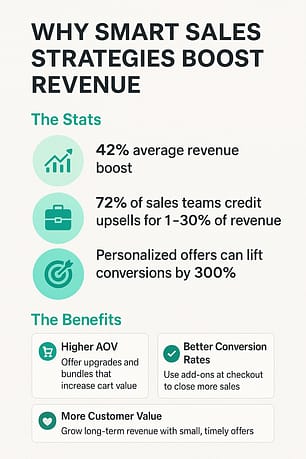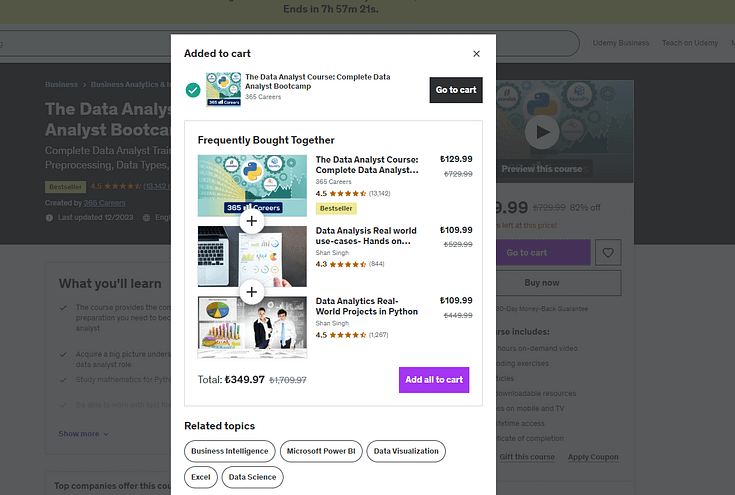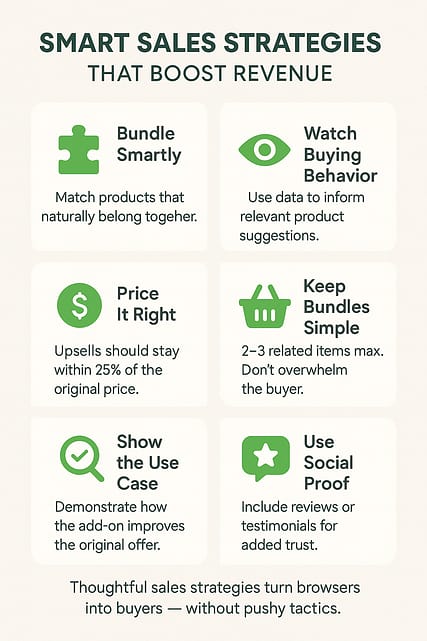If you’re putting time and energy into driving traffic — but not seeing the kind of revenue you expected — you’re not alone. One of the most common gaps in a sales funnel isn’t traffic. It’s how you guide the customer once they’re already in.
That’s where cross-selling, upselling, and down-selling come in. These aren’t advanced sales tricks or high-pressure tactics. They’re part of a smarter, more sustainable conversion strategy — one that helps you increase your average order value, improve retention, and make the most of every customer interaction.
Here’s the kicker:
- Amazon attributes 35% of its revenue to upselling and cross-selling.
- And just placing a cross-sell at checkout can boost conversions by up to 3%
(PurchaseCommerce).
You don’t need a big team or a complicated system to make these work. But if you’re not using them yet, you’re likely leaving revenue on the table — and missing opportunities to increase your customer lifetime value with minimal extra effort.
In this guide, I’ll show you exactly what these three techniques are, how they work, and how to apply them to your website, offers, or email marketing — step by step. We’ll look at real examples, share best practices, and help you turn casual buyers into loyal customers.
Why These Sales Strategies Matter More Than Ever
Getting someone to buy once takes effort. But turning that same customer into a bigger sale — or saving a slipping one — is where smart businesses really grow.
That’s where cross-selling, upselling, and down-selling come in. These aren’t just optional tactics — they’re proven strategies for boosting your average order value, increasing retention, and strengthening your sales funnel without relying on new traffic.
Here’s what the data tells us:
- Businesses that implement upselling and cross-selling techniques see a 42% average increase in revenue.
- Around 72% of sales professionals report that upsells account for 1–30% of their company’s revenue.
And this isn’t just for ecommerce giants. These strategies are just as effective for digital creators, course sellers, coaches, consultants, and service providers.

When used right, they can help you:
- Increase your average order value (AOV) with relevant upgrades or bundles
- Improve your conversion rate by suggesting the right add-on at checkout
- Maximize customer lifetime value (CLV) — without adding pressure to your funnel
You don’t need a huge team or aggressive sales tactics. You just need to understand how and when to present the right offer — and that’s exactly what we’re going to cover next.
What is Upselling?
Upselling involves encouraging a new or existing customer to purchase a higher-end product than the one they’re currently considering.
Picture a customer looking to buy a standard coffee maker. If you suggest they consider a model with a built-in grinder for fresher coffee, that’s upselling. You're not just selling them something extra; you're offering an upgrade to their original product choice.
The goal is to provide your customers with an option that delivers more value, which could result in a better experience for them and, of course, a higher sale for your business.
It's a way to make customers aware of better features or additional items they might not have initially considered but could find beneficial.
Upselling Strategies for Online Businesses
There are a few tried-and-tested ways to get your customers to purchase upsell products. Some of them include:
Tiered Pricing Displays

Clearly display different product tiers, emphasizing the benefits and value of higher-priced options.
That way, your customers can see the value of each offer, and why it may be better to purchase a higher-priced tier.
Checkout Page Prompts
Offer upgrades at checkout, like a premium version of a cheaper product at a special price, appealing to customers' desire for better value as they complete their purchase.

Present special discounts on related items that can be easily added to the cart, such as accessories for a primary product.
Alternatively you can include simple one-click options for common add-ons, ensuring convenience for customers and increasing the likelihood of additional sales.

Limited-Time Offers
Use time-sensitive offers or discounts on premium versions to create urgency.

This strategy plays on the fear of missing out (FOMO) and can be especially effective if the offer is tied to special events or holidays – like Black Friday.
Countdown timers are also a great tool to use to get the most out of these campaigns.

If you really want to tap into the power of scarcity marketing, you should use Thrive Ultimatum – the ultimate FOMO plugin.
Pop-Ups or Banners
Implement pop-ups or banners that appear when a customer selects a product, suggesting an upgrade or premium option.

These should be designed to catch the eye without being too intrusive, providing a nudge towards a better version of what they're already interested in.
You’ll need a reliable popup plugin like Thrive Leads or OptinMonster to create attention-grabbing popups that convince your customers to buy.
Comparison Charts
Use comparison charts to help customers understand the added benefits of higher-tier products.

These charts should be simple, clear, and concise, laying out the differences between the basic and premium options in an easily digestible format.
What is Cross-Selling?
Cross-selling involves presenting customers with a complementary product or service in addition to what they already bought.
Say you're picking out a new phone and just as you're about to check out, the salesperson points out a pair of headphones that would go perfectly with it. That's cross-selling.
It's about offering your customers a complementary good that is the cherry on top of your purchase – enhancing your overall satisfaction.
Cross-Selling vs Upselling
Don't confuse cross-selling with upselling; they're two sides of the same coin but play different games.
Upselling is when you're offered an upgrade to a premium phone instead of the standard one you're holding.
Cross-selling, on the other hand, sticks with your choice and simply suggests accessories that make your initial purchase even better — ideally going above and beyond to meet your customer’s needs.
Cross-Selling Strategies for Online Businesses
Product Recommendations
Use a cross-sell plugin to recommend complementary products on product pages, in the shopping cart, or at the checkout page of your online store.
Alternatively, if you’re using an eCommerce plugin like WooCommerce, you can enable the “Display Related Products” or “Frequently Bought Together” setting right from the plugin, or use a page builder like Thrive Architect to create custom product recommendation pages.

The result will depend on your theme design, but you’ll want to have a section that recommends existing or new products like this:

Email Marketing
Send targeted emails to previous customers that recommend products that complement their prior purchases.
Bundles and Deals
Offer product bundles on your website, like a camera with a tripod and carrying case at a discounted bundle price.

Or a bundle of online courses that complement each other and help customers achieve their goals faster.
What is Down-Selling?
Downselling is a strategy where you offer a more cost-effective or simpler alternative to a customer who is hesitant about a higher-priced item or service. This product is always at a lower price point than the original item.
It's essentially a plan B; if the customer decides the original product is too much for their needs or budget, you pivot and propose something more affordable.
For example, if someone's eyeing the latest smartphone but gets sticker shock at the price, you might show them last year's model instead. It's still an upgrade from what they have, but it doesn't hit their wallet as hard.
The idea behind downselling is not to lose the sale entirely but to adjust to the new customer's comfort zone with a lower-priced option that still meets their needs. This way, you maintain customer satisfaction and retain their business, even if it's at a lower profit margin.
Down-Selling Strategies for Online Businesses
After Cart Abandonment Follow Up
If a customer abandons their cart, particularly with high-value items, send a follow-up email offering a more affordable alternative.
This email could highlight the value of the lower-priced item, showing how it still meets many of the same needs as the more expensive product.
💡 Need more cart abandonment tips? Check out this detailed guide.
Offer Lower Tiered Options
Alongside premium products on your website, display more affordable options. This allows customers to compare prices and features within the same product category easily.

It's a subtle way of saying, "Looking for something more in your budget? Here's an option that still offers great value.
Exit-Intent Offers
When a customer is about to leave your site, present a downsell offer with a more affordable product.

This can be done through an exit-intent pop-up that triggers as they move to close the tab or navigate away.
How to Cross-Sell, Upsell, and Down-Sell: Best Practices That Actually Work
It’s one thing to understand the definitions — but how do you actually use these sales strategies in your business?
The key is to align your offers with customer intent and timing. Whether you're optimizing your sales funnel, improving your conversion rate, or increasing average order value, small changes to how you position related products can make a big impact.
Here’s how to do it effectively — without feeling pushy or overcomplicating the experience:
✅ Match Products That Naturally Belong Together
Some products just make sense as a pair — like a tripod with a camera or a template pack with a course.
Use those connections to create strategic product recommendations that feel helpful, not forced. The easier it is for customers to say “yes,” the more likely they will.
✅ Watch What Customers Already Buy
Pay attention to your customer behavior and purchase history. Are there patterns in what buyers tend to purchase together? Use that data to inform cross-sell placements or personalized email marketing follow-ups.
✅ Price Smart — Not Just Low
When offering an upsell, make sure the price jump feels like a no-brainer. A common guideline: keep upsell pricing within 25% of the original product’s price.
This helps you increase revenue without adding resistance.

✅ Don’t Overwhelm With Bundles
A good bundle makes the buying decision easier. A bloated one does the opposite. Stick to 2–3 complementary items in a bundle — anything more can confuse the buyer and hurt your conversion rate.
✅ Show the Use Case
Whenever possible, demonstrate how the cross-sell or upsell product actually improves the original one.
Example: Selling a smartphone? Show how a durable case protects it. Selling a course? Highlight how the upsell workbook speeds up implementation. Real use cases = faster decisions.
✅ Leverage Social Proof
Buyers trust buyers. Include testimonials, ratings, or short quotes from happy customers to build confidence around the extra item.
This is especially useful when upselling higher-ticket items or introducing new offers in your funnel.
❓ Cross-Selling, Upselling & Down-Selling – FAQs
1. How do I know whether to cross-sell, upsell, or down-sell?
It depends on where the customer is in their journey. If they’re already buying and open to better features or more value, that’s a prime upsell opportunity. If they’ve made a decision and you can enhance it with a related item (like accessories or add-ons), that’s where cross-selling shines. And if they seem hesitant or abandon cart, a down-sell — a simpler or more affordable option — can save the sale.
2. What’s a good price point for an upsell?
Keep it close. A common benchmark is to offer upsells that are no more than 25% more than the original item. This keeps the upgrade within a reasonable range — enough to boost your average order value, but not so much that it causes sticker shock.
3. How many products should I include in a bundle or cross-sell offer?
Less is more. Aim for 2 to 3 related items that clearly make sense together. Too many options can overwhelm your customer and lower your conversion rate. The goal is to make buying easier — not to add friction.
4. Does personalization really improve upsell and cross-sell results?
Absolutely. Tailored product recommendations based on customer behavior or past purchases can boost conversions by up to 300%. When offers feel relevant and timely, they feel helpful — not salesy. That’s the sweet spot.
Next Steps: Design Your Next Sales Funnel
Your upsell, cross-sell, and downsell strategies are only as effective as your overall sales funnel.
So, use this time to review your current funnels and identify the areas that need improvement.
Here are four free resources to help you get started:
And if you need better tools to design high-converting sales funnels, then you should consider Thrive Suite, the best WordPress plugin bundle in the game.
When you purchase Thrive Suite, you get access to 10 premium plugins to enhance your funnels and generate more sales for your business.
Use these plugins to:
Offer timely upsell and downsell popups with advanced targeting and high-quality templates
Easily create attention-grabbing sales pages with our drag-and-drop page builder and library of customizable templates
Drive up audience engagement (and refine your segmentation) with engaging quizzes
Get the most out of limited-time offers with eye-catching countdown timers and clever targeting
…and so much more
Cross-Selling, Upselling, Downselling: Final Words
Cross-selling, upselling, and down-selling might seem like small add-ons in your overall sales funnel strategy — but they can lead to significant growth when applied with purpose.
- Cross-selling helps you enhance the customer journey by recommending complementary products that make the original purchase more valuable.
- Upselling nudges customers toward a higher-tier option — not by pushing, but by clearly showing the added benefits of upgrading.
- Down-selling offers a fallback when someone hesitates, giving them a more accessible path to purchase without losing the relationship.
Together, these strategies work behind the scenes to boost your average order value, strengthen trust, and increase your customer lifetime value — all without adding more pressure or complexity to your funnel.
If you're just getting started, don’t overthink it. Start small. Test one well-placed upsell or cross-sell offer. Watch how your audience responds. Then refine and scale your conversion strategy based on what actually works.
The beauty of these techniques is that they meet your customer where they are — and move them one step closer to saying yes.



Thank you for the comprehensive article!
The only thing I did not understand is how to implement the upsell / downsell etc. funnel flow. I haven’t found these options in Thrive Themes.
Hey Dario!
Thanks for reading through! We just published a post on how to implement a upsell/cross-sell funnel, and it includes suggestions on when to offer a downsell.
How to Create an Upsell/Cross-Sell Funnel for an Online Course
Typically you’ll build your upsell, downsell, or cross-sell pages with Thrive Architect, or popups with Thrive Leads. You’ll then insert the link to these pages in your checkout tool, or embed the popup on a checkout page (it depends on the tool you’re using)